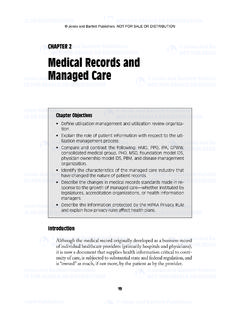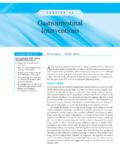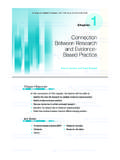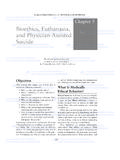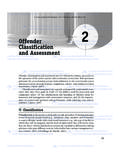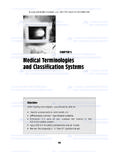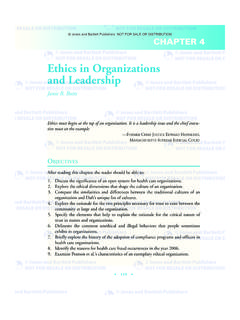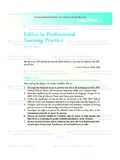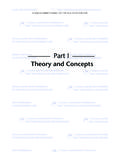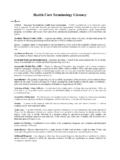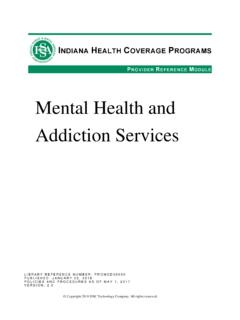Transcription of Evolution of Health Education, Health Promotion, …
1 Chapter 1. Evolution of Health Education, Health Promotion, and Wellness Programs EARLY ORIGINS. A search for the origins of Health promotion leads to the earliest civiliza- tions. Certainly the fundamental needs of shelter, food, water, and safety are Health related, and the writings of the Babylonians, Egyptians, and Old Testament Israelites indicate that various Health promotion techniques were utilized. For example, there were community systems to collect rain water or otherwise provide safe drinking water. There were various sewage disposal methods, includ- ing the use of earth closets. Personal cleanliness was advocated. Intoxication was recognized as troublesome. Disease, though not understood, was known to be contagious and various forms of quarantine were used, as were herbal medicines.
2 Days of rest were prescribed and sexual conduct was regulated. Dietary restric- tions were numerous, and various sanitary restrictions governed the supply and preparation of food. Regulations regarding menstruation, pregnancy, and child- birth evolved. Exercise was advocated. In some places building regulations were set, and street cleaning and garbage removal began to occur regularly. Mental Health and spiritual Health ( , a sense of harmony) were advocated. As more was learned about disease transmission, more methods to help control and prevent disease were instituted, such as immunization. Various Health care facilities and public Health systems were developed to provide better treatment and prevention services.
3 In most early civilizations, Health and religion over- lapped. Organized religion sponsored many of the earliest Health care facilities and practitioners of the healing arts. At various times peoples have portrayed God as visiting disease and destruction on sinful people, as well as being the source of healing for righteous people. In some civilizations, the first temples were also the first hospitals. Medical missionaries have been common to many religions and societies. Regardless of the motivation, religious practitioners' desire to improve . 1 9/27/06 9:57:20 AM. Managing Health Education and Promotion Programs the Health and well-being of others has been a powerful force in the history of medicine, Health education, and Health promotion.
4 Among the positive contributions of religion has been its influence on gov- ernment institutions and on those who govern. The impact of religion and gov- ernment on Health promotion and wellness programs cannot be fully separated, because many people tend to express their religious commitment through govern- ment involvement. Further, the tremendous impact of religion and government on these programs is matched only by the impact of science and technology. The roots of today's Health promotion and wellness programs lie in the Industrial Revolution. The creation of large factories meant that thousands of people were brought together in congested, unsafe worksites located in congested, unsafe cit- ies.
5 The inhumane conditions gave rise to numerous labor laws and worksite programs, not to mention labor unions demanding that the perspective of workers be considered. Labor union negotiations resulted in various insurance programs that changed medical facility and service utilization patterns. Insurance programs became more accepted by society and more pervasive, and they eventually evolved into nation- alized systems that encompassed prevention as well. Economics have always been at the center of such negotiations, and cost reduction or cost shifting was frequently among the most important issues that arose. Science and technology have had a significant impact on prevention by provid- ing an understanding of the causative roles of pathogens and how to immunize people.
6 Similarly, discovery of the effects of diet, exercise, and substance abuse on chronic disease led to the Evolution and elevation of prevention programs. However, science and technology have contributed more to the curative side of disease and disorder through the assortment of disease-specific miracle drugs, therapies, and surgeries they have made available. Of course, the ascendance of technology in Health care caused costs to escalate rapidly and making Health care accessible and affordable to all became an important goal of providers and third- party payers. CONTEMPORARY MILESTONES. There are numerous possible starting points from which to choose when dis- cussing the contemporary focus on Health promotion and wellness.
7 According to a widely quoted definition, Health promotion is the combination of educational and environmental supports for actions and conditions of living conducive to Health . 1 This definition provides a useful framework for describing the contem- porary situation. Health education has traditionally been used to refer to educational interven- tions. Over time this term has become more inclusive (and coincidentally such 2 9/27/06 9:57:21 AM. Evolution of Health Education, Health Promotion, and Wellness Programs . interventions have become more effective). The basic approach evolved from the moralistic ( Don't do it because God or the church doesn't want you to. ) to the legalistic ( Don't do it because it's against the law.)
8 With this shift, educational programs began to focus on possible harmful effects of certain substances or behaviors and why they were illegal. Of course, one objective was to explain what would happen to lawbreakers if caught. Another was to urge legislators and others to engage in social engineering, such as passing laws mandating safety-related provisions, such as the use of air bags. The educational process has changed as well. The original models were cogni- tive (presenting the facts), but they were replaced by affective models (changing attitudes), peer-counseling and peer support models, decision-making models, alternative models, and, most recently, behavioral models. For a discussion of these models and how Health education and Health promotion have evolved, see Community Health Education: Setting Roles and Skills for the Twenty-First This paradigm shift in the profession did not just happen.
9 It was made to hap- pen by practicing professionals and college professors whose research and writ- ing focused on finding ways to increase the effectiveness of the programs they advocated. As data accumulated and the profession matured, more leadership efforts were devoted to institutionalizing Health education, Health promotion, and well- ness programming, primarily through government mandates and through focus- ing on economic issues in business and industry. The creation of the President's Committee on Health Education in 1973 was an important early event. This com- mittee, among other things, legitimized a nationwide emphasis on Health educa- tion and an expanded role for government in developing model programs and providing seed money for their implementation.
10 It recommended, for example, creation of a National Center for Health Education, which occurred in 1975. The Center successfully pushed for expanded worksite programming as well as nation- wide programming, professional credentialing, and comprehensive school Health education programs. Two seminal works that influenced the profession were the 1979 Surgeon General's report on Health promotion entitled Healthy People, and the 1980 report entitled Promoting Health , Preventing Disease: Objectives for the Nation. In 1980, the Government also created a separate Department of Education in the Department of Health and Human Services and gave it responsibility for sup- porting Health education, Health promotion, and wellness programming.

